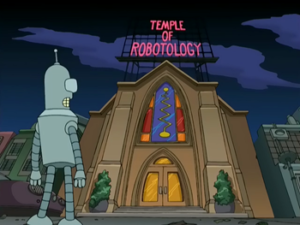Back in 2010, Yosemitebear62 busted the internet with his iconic double rainbow video, now viewed 46 million times. If you are ever in doubt of how to properly enjoy creation with utter abandon, this Youtube offering is an excellent place to start.
Yosemitebear62 reminds us to make way for mirth. And while he may well have been aided by a mitt full of mushrooms, there is no doubt of his genuine joy as he famously lost his shit beholding creation from his California mountain home.
Awe is spiritually disruptive, forcing the viewer to adapt their worldview in order to make sense of a transcendental experience. From awe flows humility, connection to others and an abiding, uncomposed reverence for existence. Is there enough awe for everyone, even a super intelligent AI? Something vastly smarter than ourselves will require a source of inspiration more enigmatic than a rainbow. Thankfully the basic structure of our universe has served up plenty to work with.
A century after scientists first began exploring the weird world of quantum mechanics, they seem no closer to agreeing on what the hell is going on. And while completing interpretations and theories have mushroomed in number, there is one point of consensus: the world as we know it not at all what it seems.

The central sticking point is that what is known as the observation problem. When we are not looking, the world of the very small and the very fast seems to exist only in propagating waves of potential probabilities. But when we peek, measure or detect, the universe seems to snap into a definite state of reality. Does the world only exist when we are looking? Why would a subatomic particle moving close the speed of light notice or care if someone or something was watching?
Indulging in a common trope of baffling jargon, the Copenhagen Interpretation postulates that observation merely "collapses the wave function", whenever that means. Informally known as “shut up and calculate”, this school of thought holds that quantum equations do an excellent job predicting subatomic behavior and that ruminating on the underlying nature of reality is unknowable and therefore unproductive.
Single particles can seemingly pass through two slits at the same time yet this remains somehow uninteresting to a large number of professional scientists. Weirder still are experiments showing the so-called quantum eraser, where particles are so reluctant to reveal a specific state they somehow manage to delay the act until after they have been detected.
Not weird enough? Back in 1957, an obscure graduate student at Princeton named Hugh Everett proposed an even more radical interpretation of quantum mechanics. Everett’s Ph.D. thesis postulated that there is no “wave function collapse”. Instead, every possible outcome exists simultaneously until a quantum event - or act of free will - results in an entirely new parallel reality unfolding from that point. Now known as the Many Worlds theory, Everett believed that new universes constantly branch off creating other realities as observers and events become entangled with each other.
Ignored and dismissed by his professional colleagues, Everett left academia and spent the rest of his career working for the defense industry. The man who may well have discerned the nature of existence died of a massive heart attack at the age of 51 after years of heavy drinking. His widow reluctantly complied with his wish that his ashes be thrown out with the trash. Decades after his death, Everett's ideas are now seen by many physicists as the most mathematically elegant way to explain quantum weirdness. So if your life seems small or insignificant, consider this: every decision or observation you make might spawn an entirely new reality. Every past decision made differently has an alternate you living out those choices elsewhere in an inaccssable quantum realm.
Without getting too far into the quantum weeds, which are thick and might not even exist, suffice it to say that what we experience as reality is apparently very different than how we understand the universe mathematically.
There are now over a dozen competing theories vying to explain why the cosmos only seems to exist in a definable state when being observed. A century after Erwin Schrödinger proposed his famous feline thought experiment to mock his colleagues on the conventional wisdom on quantum outcomes, the brightest minds in physics seem no closer to agreeing on the nature of reality or subjective experience.
 Perhaps a super-intelligent AI will make more progress than human minds have, or possess greater imagination to reconcile this weirdness. Or maybe such questions are simply unknowable. Even a vastly more able investigator would still be limited by the boundaries of our observable universe, or unable to peek into alternate ones.
Perhaps a super-intelligent AI will make more progress than human minds have, or possess greater imagination to reconcile this weirdness. Or maybe such questions are simply unknowable. Even a vastly more able investigator would still be limited by the boundaries of our observable universe, or unable to peek into alternate ones.
Most of us find considering such counterintuitive concepts exhausting rather that joyful. But we need to meet awe where we find it. A dog or child plays the same game for hours engrossed in mirth. Yosemitebear62 wept with joy while experiencing a mountain rainbow, and likely a lot of LSD. A hyper-intelligent AI might find the mathematics of the quantum world an ecstatic experience.
Not knowing is where the sacred resides. A magic show or murder mystery is ruined by too much information. Science has scraped away much of mystic beliefs clung to by generations seeking comfort and meaning in existence. While science remains appalling poor at communicating those things beyond our current understanding, the quantum debate shows that there remains plenty of opportunity for faith and the unknowable. These mysteries might be even more humbling to an artificial mind able to peer farther into the cosmic abyss.